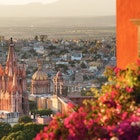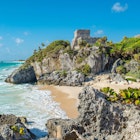
Sep 17, 2025 • 11 min read
It is one of the world's most universally familiar festivals, but what do you need to know about attending Día de Muertos in Mexico?

Sep 17, 2025 • 11 min read
It is one of the world's most universally familiar festivals, but what do you need to know about attending Día de Muertos in Mexico?

Sep 3, 2025 • 7 min read
This new rail project connects sites around the Yucatán Peninsula. Here's what to know before you get on board.

Aug 6, 2025 • 8 min read
Mexico's beauty goes far beyond the resort strips and tourist hotspots that dominate most vacation itineraries

Jul 10, 2025 • 16 min read
With FIFA World Cup matches in Mexico, Canada and the USA next summer, traveling football fans are spoiled for choice. Here's our guide to where to go.

May 13, 2025 • 8 min read
Mexico offers something for every traveler and type of adventure. Here are a few of the top places to visit in the country.

May 13, 2025 • 5 min read
Mexico’s indigenous communities are vibrant and resilient, contributing profoundly to the nation's culture, politics and social landscape.

May 9, 2025 • 8 min read
From swimming in cenotes and eating street food to soaking up the history and culture of this vibrant nation, here are the best things to do in Mexico.

May 8, 2025 • 5 min read
Mexican culture is deeply linked to Mexican cuisine, making it incredibly easy and fun to experience both simultaneously.

May 7, 2025 • 8 min read
Whether your passion is surfing, hiking, bird-watching or kiteboarding, Mexico is the place for outdoor advetnures. These are the country’s top ones.

May 2, 2025 • 7 min read
Mexico has a small but ambitious rail network that is rapidly expanding. Here are the best so far.

Apr 29, 2025 • 7 min read
We’ve selected dozens of our favorite hotels, hostels, resorts and unique accommodations that will appeal to every kind of traveler.

Apr 29, 2025 • 11 min read
Explore the best of Mexico with these itineraries that take you to historic cities, stunning beaches and beyond.

Apr 22, 2025 • 8 min read
Explore Mexico's ancient and more recent history on foot and by rail.

Mar 27, 2025 • 11 min read
Whether you opt for a quick dip or want to linger for hours on the soft sands, Mexico’s stunning beaches are one of the best parts of any trip to the country.

Mar 3, 2025 • 13 min read
Celebration takes myriad forms as you travel across the globe, from Brazil's Carnaval to the Edinburgh Fringe. Here are the top festivals in the world.

Feb 24, 2025 • 10 min read
Beyond Baja, the Pacific unfurls in a wildly diverse stretch of coastline, where each region serves up a completely different energy.

Feb 21, 2025 • 9 min read
Finding a beach in Mexico is easy, but getting away from the crowds is a little more challenging. Here are the best off-the-grid beaches to get away.

Feb 12, 2025 • 7 min read
Planning to visit Mexico? Lucky you. From tipping to safety to etiquette and beyond, here are some pointers to keep in mind as you plan your trip.

Jan 24, 2025 • 8 min read
Mexico’s best experiences are worth writing home about. Here's how to keep your cell connected.

Jan 21, 2025 • 12 min read
The magnificent underground water networks known as cenotes are a signature attraction of Mexico’s Yucatán Peninsula. These are 10 of the best ones.

Oct 25, 2024 • 5 min read
Beach lover, culture maven, history buff or foodie – Mexico has a perfect time for you to experience its countless treasures.

Oct 25, 2024 • 5 min read
If you’re planning a trip to Mexico, here's what you need to know about visas, visa-free travel, tourist permits and more.